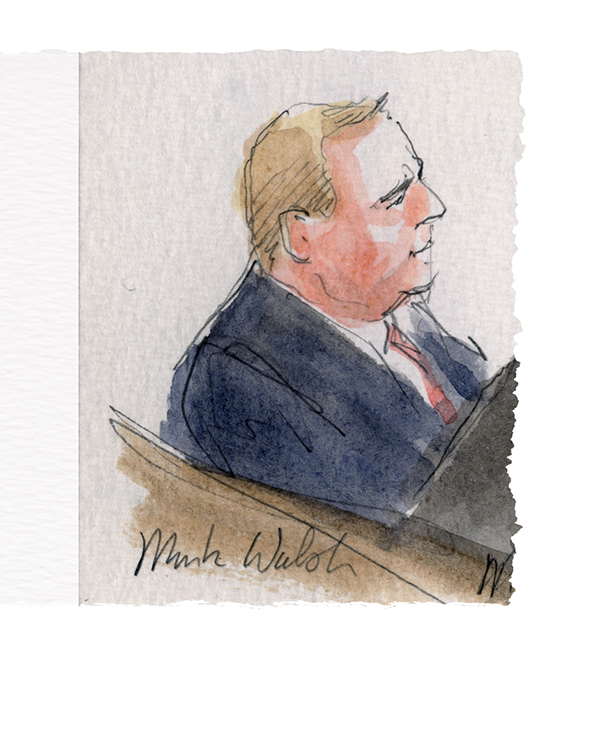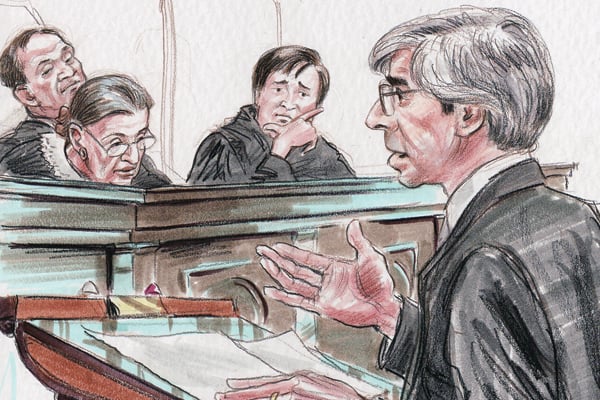Art Lien sketched court figures for 45 years, from blockbuster cases to the arcane

Art Lien captured Chief Justice John Roberts tearing up on Justice Stephen Breyer's last day on the court. (Original artwork by Art Lien)
On Art Lien’s last day as a working sketch artist in the U.S. Supreme Court in spring 2022, he dutifully drew lawyers arguing the final case of the term. Then he had to pivot as a slightly unexpected moment broke out: From the bench, Chief Justice John Roberts became a bit emotional as he lauded Justice Stephen Breyer on his impending retirement.
Lien pulled out his smaller sketchpad and quickly captured the scene, which was unfolding in late April. Because the justices would not be taking the bench to deliver opinions after that, this was the last time they would be in the courtroom before Breyer stepped down in June.
Lien also retired at the end of that 2021-22 term after 45 years of sketching the court. “I turned 70, have no debts and my eyesight isn’t getting any better,” Lien says. “It was time.”
(Lien provided the sketches for these articles.)
Related article: Supreme Preparation: What attorneys go through before facing the nine.
Stumbling into court
When Lien started sketching the high court in 1977, Warren Burger was chief justice, and the court’s first woman, Justice Sandra Day O’Connor, was still four years from taking the bench. Lien had graduated from the Maryland Institute College of Art one year earlier and stumbled into a job sketching trials for a Baltimore TV station.
Soon he was accompanying longtime CBS News sketch artist Howard Brodie to the court and the chambers of Congress, which had not yet allowed TV cameras. Brodie was getting ready to retire, and he pushed for Lien to take his job, even though the young artist was having trouble completing his sketches on deadline.
“It was all very overwhelming,” Lien says. “But I did get the job.”
Lien later shifted to NBC News. As a courtroom artist for network television, he sketched the highest-profile cases in the Supreme Court while also covering notorious trials such as those of Oklahoma City federal building bomber Timothy McVeigh and Boston Marathon bomber Dzhokhar Tsarnaev.
Case studies
Lien considered himself a reporter as much as an artist, though he admits that for much of his early time, he didn’t take time to read all the briefs of a case. In 2013, Lien picked up the additional gig of sketching regularly for SCOTUSblog, a website that covers the court comprehensively. Lien found himself sketching lawyers arguing some of the most arcane, low-profile cases on the court’s docket.
 Art Lien’s portrait of Mark Walsh, author of this article and longtime U.S. Supreme Court reporter.
Art Lien’s portrait of Mark Walsh, author of this article and longtime U.S. Supreme Court reporter.“I really started to understand how things worked, and if a lawyer mentioned Chevron deference, I knew what that meant,” he says, referring to a major 1984 decision on court deference to federal agency action. “Of course, I had sketched the Chevron argument itself, so that helped too.”
Lien, who usually sat in an alcove of the press section in the courtroom just a few dozen feet from the bench, says his own interactions with the justices were few and far between during his 45 years, though there were requests for originals or prints of his sketches from members of the court and from the lawyers who were pictured arguing. He does not recall getting any courtroom glares from his subjects, at least not in the way TV mobster Corrado “Junior” Soprano once stared daggers at a courtroom artist whose sketches didn’t meet his approval in an episode of The Sopranos.
Lien likes to tell the story of when a display of courtroom art was on the ground floor of the Supreme Court, and the diminutive Irish-American Justice William Brennan studied one of his sketches and then told him: “You always make me look like a leprechaun.”
In the courtroom, Lien did his base sketches in pencil, then added watercolors later for the red curtains, the mahogany bench and the pigments of the participants’ faces. He would use a monocular to capture details, and he would notice little things such as the handful of experienced and supremely confident advocates who would take no notes to the lectern.
Sketching remotely
When the COVID-19 pandemic forced the court to conduct arguments over the telephone in spring 2020 and during the entire 2020-21 term, Lien and SCOTUSblog hit on the idea of asking advocates to have someone snap a photo of them delivering their remote arguments. Lien then drew sketches from the photos. Some advocates set up photos of the justices as if they were on the bench. Many dressed as if they were in court, and one lawyer delivered his argument in jeans and a hoodie.
Kannon K. Shanmugam, a partner at Paul, Weiss, Rifkind, Wharton & Garrison and a frequent advocate before the court, wrote in tribute to Lien in SCOTUSblog last year: “Over the years, Art has captured all of the big moments of my career and those of so many others—including in his famous sketches of the telephonic arguments during the pandemic. … At the risk of going all Carly Simon here, nobody does it better.”
While the high court has been livestreaming the audio of its arguments since it returned to the courtroom in fall 2021, it has resisted the many calls to allow video cameras. That means courtroom artists will continue to have a place there, although only two remain credentialed: William Hennessey of CBS News, and Dana Verkouteren of the Associated Press.
Lien, who has been working on and riding his numerous bicycles around Catonsville, Maryland, where he lives, and otherwise “trying to figure out what I want to do,” says he sometimes listens to the audio of arguments.
“I do miss it sometimes,” he says. “I miss the camaraderie of the press room at the court. But I haven’t really done any artwork since I retired.”




